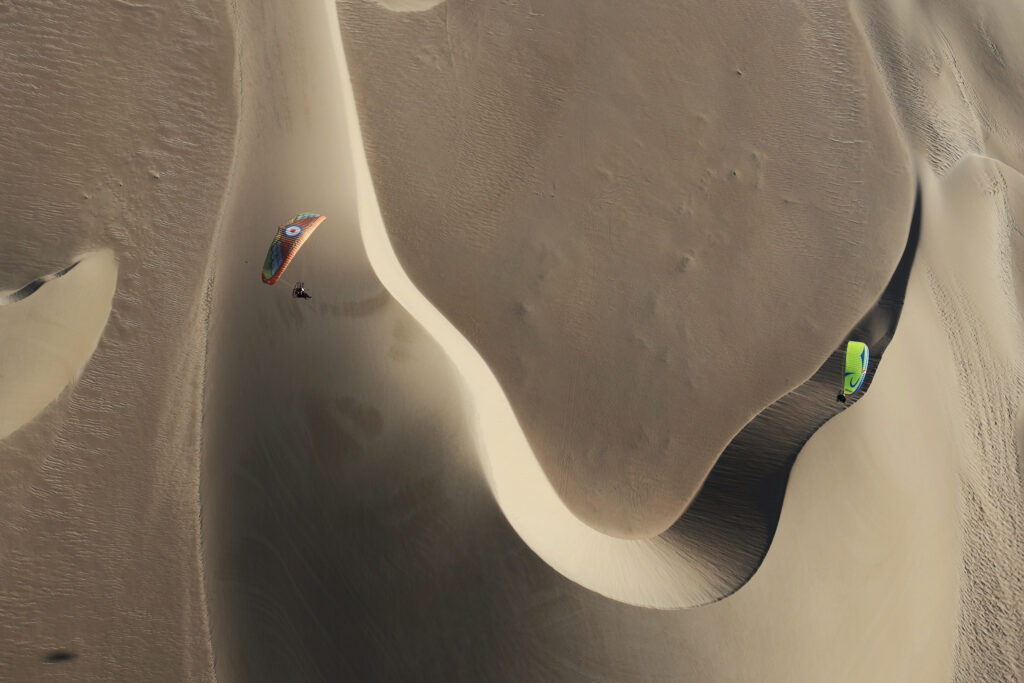In 2009, South American deserts stretching from Peru’s parched coast to the wilds of Patagonia became a playground for the global off-road racing elite. Each year since, thousands of riders on motorcycles, buggies and jeeps have torn through the dunes, leaving vast, untamed landscapes crisscrossed with the scars of rough tires.
Few have witnessed the consequences of this unchecked invasion on some of the region’s most fragile and irreplaceable sites as intimately as Alfonso Orellana Garcia. The Peruvian biologist has spent over two decades studying a unique fog oasis ecosystem on the Peruvian coastline known as Lomas y Tillandsiales de Amara y Ullujaya, or “lomas.”
“Tire marks not only damage the landscape but also affect the species of flora and fauna that live here,” he said. But even the scientists trying to protect these habitats face a paradox. The very act of research—traversing the desert in all-terrain vehicles to collect data—leaves its own trail of damage.
“We try to minimize our impact by driving as little as possible and walking long distances for our studies,” Orellana Garcia added. “But we are also part of the problem.”
Orellana Garcia and a team led by geographer Justin Moat, from the Royal Botanical Gardens, Kew, in England sought a new possible solution. Instead of navigating the sands in vehicles, they took their research to the skies.
Soaring above the Peruvian Sechura Desert in paramotors—motorized paragliders—they blended the thrill of extreme sports with the precision of scientific exploration. Arriving from the air, landing lightly on their feet, gave them a way in without the damaging tires. It also allowed them to reach areas that researchers have never studied before due to the difficulty of accessing them.
Islands of Vegetation in the Desert
Stretching along nearly 1,900 miles (3,000 kilometers) of the Pacific coast, the fog oases of the Peruvian and Chilean deserts form a rare and delicate ecosystem.
Lomas, shaped by 15 million years of evolution, rise like “islands” atop the desert hills, sustained by a delicate and rare ecological balance, Orellana Garcia explained. Their survival depends entirely on the dense fog that drifts inland from the water, providing the moisture essential for life in an otherwise desolate region. This unique maritime climate—one of the few in the world to support a terrestrial ecosystem—exists only here, where warm tropical waters converge with the frigid currents of the Pacific Ocean, creating a mist that breathes life into these isolated oases.


The lomas provide critical ecosystem services, offering everything from moisture to genetic resources that have sustained species in one of the planet’s harshest environments. Yet these fragile landscapes remain shrouded in mystery. The seasonal fog that gives life to the oases also obscures them, leaving vast swaths poorly mapped and largely unprotected.
Moat started studying the area 25 years ago. In 2021, he and conservation group Huarango Nature created a map of the vegetation there using satellite data from 2000 to 2020. The researchers identified about 1,200 species of endemic flowering plants, 30 percent of which are in Peru.
After years of monitoring, the scientists succeeded in getting the Peruvian National Forestry and Wildlife Service to designate nearly 16,000 acres of cloud oasis as a conservation area earlier this year. This measure has been helpful in strengthening control over desert races, said Orellana Garcia, who served as an expert analyst helping the government reduce the impact of major events like the 2012 Dakar Rally. However, the issue extends beyond official races—unauthorized drivers often enter the desert unsupervised, posing a significant challenge for local authorities, who are unable to maintain constant surveillance over the vast expanse of desert.




Among scientists, concern remains high. To protect the fragile areas in their totality, they first have to understand the full breadth of life these ecosystems harbor.
At least 25 percent of the endemic plant species in the lomas are now teetering on the brink of extinction. These fragile ecosystems are not only highly vulnerable to climate change, Moat said, but they also act as sensitive indicators of environmental shifts, including the evolving patterns of the El Niño climate phenomenon that alters the Pacific jet stream.
Gliding Over the Desert
To deepen their understanding, Moat and Orellana Garcia turned their focus to one of the most elusive species of the ecosystem: tillandsia, often referred to as “air plants.” These enigmatic species, with their trichome-covered leaves that scatter light in complex patterns, have long defied study via satellite imagery, rendering them virtually invisible from above. The peculiarities of their biology have made them one of the least researched species in the region.
Tillandsias have unique genetic adaptations that allow them to survive in desert environments. In the lomas deserts, these species are spread across various islands, and assessing the genetic differences between them can provide valuable insights into how shifting weather patterns are impacting local plants, said Carolina Tovar, an ecologist at the Kew Botanical Gardens.


Determined to gather data without disturbing the delicate desert surface, the researchers enlisted an unconventional team. They partnered with the Brazilian paramotor group Aita Escola Nacional De Paramotor and Forest Air—a French group that pairs professional paramotorists with scientists for aerial surveys.
A paramotor is a small, lightweight aircraft consisting of a propeller engine attached to the pilot, who is seated or harnessed, and a fabric paraglider wing. To take off, pilots typically run a short distance, allowing the wing to catch the wind and generate lift. Once airborne, they control their direction and altitude using mechanical controls connected to the glider’s lines and the engine’s throttle.
This story is funded by readers like you.
Our nonprofit newsroom provides award-winning climate coverage free of charge and advertising. We rely on donations from readers like you to keep going. Please donate now to support our work.
A team of scientists in ground vehicles ventured into the desert alongside paramotor pilots and set up camp to plan, monitor upcoming missions and give the paramotorists basic training in species collection and field observation. The expedition lasted seven intensive days in November 2022, covering approximately 300 miles by land and air. Paramotorists were able to fly into areas the scientists would have been hard-pressed to reach by car. But the ground team did retrace the path of two shorter flights to compare the environmental impact.The results of their investigation were published in the journal Plants, People, Planet last month.
Damage caused by the paramotorists on the desert’s fragile surface was minimal compared to the havoc wreaked by four-wheel-drive vehicles. While the off-roaders left scars across at least 23,000 square meters of land, the paramotorists’ footprint barely registered—just 24 square meters at most.
“They’re almost 10,000 times less invasive than a car,” Moat noted.
For shorter trips, paramotors and cars produced similar amounts of carbon emissions. But the real difference emerged over longer distances. “When we looked at the longer trips,” Moat explained, “a car would release two or three times more CO2, because they’d be traveling for four or five days, while the paramotors could complete the same journey in just a few hours.”


The paramotorists soared over the desert, landing briefly to collect samples before taking off again. In total, they gathered 25 samples of tillandsia, which scientists are now analyzing in the lab to better understand and catalog the vegetation that thrives in the fog oases of the lomas.
Orellana Garcia, who has been studying the desert since 2001, said rising sea temperatures are impacting the fog oases, with ripple effects on the flora and fauna that depend on them. Over the years, he has seen the vegetation that typically flourishes between November and December steadily diminish, forcing several bird communities to abandon the area.
While more research is needed to fully grasp the impact of climate change on lomas biodiversity, “it’s not hard to imagine that the longer the drought periods, the less haze there is, affecting vegetation cover and species,” said Tovar. “We could face a potential extinction of local species that can’t withstand the new conditions.”
Monitoring is crucial not only for understanding species’ responses to climate change but also for developing effective conservation strategies and designating more zones as protected areas, Orellana Garcia said.
The lomas research shows how extreme sports and outdoor recreation can help. Whether mountaineers, rock climbers, sailors, scuba divers, kiteboarders, surfers or canoeists, “they are becoming vital allies in safeguarding the planet’s most fragile landscapes,” Moat said.
About This Story
Perhaps you noticed: This story, like all the news we publish, is free to read. That’s because Inside Climate News is a 501c3 nonprofit organization. We do not charge a subscription fee, lock our news behind a paywall, or clutter our website with ads. We make our news on climate and the environment freely available to you and anyone who wants it.
That’s not all. We also share our news for free with scores of other media organizations around the country. Many of them can’t afford to do environmental journalism of their own. We’ve built bureaus from coast to coast to report local stories, collaborate with local newsrooms and co-publish articles so that this vital work is shared as widely as possible.
Two of us launched ICN in 2007. Six years later we earned a Pulitzer Prize for National Reporting, and now we run the oldest and largest dedicated climate newsroom in the nation. We tell the story in all its complexity. We hold polluters accountable. We expose environmental injustice. We debunk misinformation. We scrutinize solutions and inspire action.
Donations from readers like you fund every aspect of what we do. If you don’t already, will you support our ongoing work, our reporting on the biggest crisis facing our planet, and help us reach even more readers in more places?
Please take a moment to make a tax-deductible donation. Every one of them makes a difference.
Thank you,




